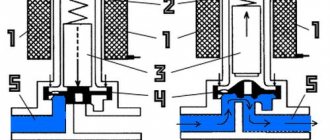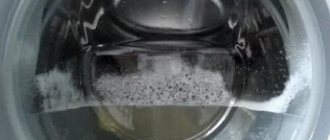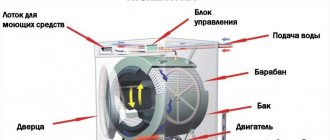Most owners are sure that it is impossible to repair large household appliances without the help of qualified technicians; for example, it is unlikely that they will be able to find out why the dishwasher does not fill with water or the causes of the problem. This is partly true - only specialists can handle complex damage.
Before you start repairing your dishwasher, read this article
In this article we will tell you how to localize and eliminate one of the common malfunctions of a dishwasher (hereinafter also referred to as PMM, dishwasher) without resorting to the services of a technician.
Preventing the problem from recurring
To prevent the problem from reoccurring, you should follow simple rules:
Maintain the device according to the regulations.- Install the dishwasher correctly.
- Clean filters on time.
- Check the condition of the hoses and avoid kinks.
- Install a voltage stabilizer to avoid power surges, which can be dangerous for any household appliance.
Find out everything you need to know about dishwasher water in this section.
Water does not flow into Bosch PMM: reasons
The quality of assembly of equipment by the German corporation Bosch is known throughout Europe and beyond. But even the most reliable household appliances are not immune to failures. Often, the majority of problems are caused by violation of operating rules, incorrect installation, power surges, etc. Therefore, manufacturers have nothing to do with most breakdowns. Analyzing the real reasons why there is no water supply to the Bosch dishwasher, we note the following points:
- There is no water or insufficient pressure in the water pipe.
- The valve is closed, which is why the system does not supply water to the PMM.
- The inlet hose is kinked or pinched.
- The Aquastop system worked, causing the water intake to be blocked.
- A power surge caused the solenoid start valve to fail.
- The hopper door is not closed tightly enough, which is often accompanied by a flashing liquid supply indicator.
- Level sensor failure. In the event of a failure, the sensor transmits incorrect data to the module, which is why water is not poured into the system.
- The filter screen installed on the inlet valve is clogged. The fastest way to solve the problem is to simply remove and wash the filter mesh.
- Failure of an electronic unit is a rare and complex breakdown that practically excludes self-repair.
Important! Do not try to find the cause of the module failure yourself: repairing it is the task of specialists. You will need a special tool and certain skills.
Let's look into it in detail
If there is no water in the water supply, then you need to be more careful and read the warnings on the notice board in front of your entrance - the Housing Office always warns residents about possible water outages due to maintenance work. It is not difficult to check whether the water supply tap to the dishwasher is open and the condition of the inlet hose; however, it is not difficult to determine whether the aqua-stop has worked or not.
Inlet valve
This part is available on absolutely all brands and models of dishwashing machines. If it is faulty, then water will not be drawn into the unit’s system, because the valve will not be able to open access to the inlet hose.
Voltage drops constantly occur in the city electrical network, so excess voltage may be supplied to the electromagnet winding, causing it to burn out. If the winding is faulty, then the signal does not arrive at the rod, and the elastic rubber membrane continues to block the input.
This product cannot be repaired - it needs to be replaced. If you do not understand anything about the technical features of household appliances, then it is better to invite a technician from the service center.
Important! When replacing the solenoid inlet valve yourself, remember that it must match the brand and model number of the dishwasher.
Many home craftsmen successfully and without problems cope with such a replacement and save the family budget.
Loading door
As long as it is not closed tightly, the machine will not work. You need to press it until you hear a characteristic click; if even after that the water intake does not start, then the reason is in the blocking system. What to do in this case? First of all, do not panic, unplug the machine and carefully inspect all the door elements:
- deformation, even the slightest, of the sealing rubber always leads to the door not closing tightly;
- we inspect the lock - if faults are found, we replace it or repair it;
- we check the installation of baskets and containers - if installed incorrectly, they prevent the door from closing tightly;
- If the machine is not level, the door may not close completely due to extraneous interference.
If the reason for the loose closure is a lock, then you can replace it yourself, just purchase a new lock specifically for your model in advance. The lock replacement algorithm is quite simple:
- Open the door and unscrew the fastening screws. Carefully! The edges of the stainless steel coating on the inside are very sharp - do not cut your hands. Hold the top panel so that it does not fall out.
- Carefully disconnect the wire connection terminal.
- Unscrew the fasteners on the top and move the lock to the side.
- We install the new one in place and connect the terminal.
- We insert the top panel into place and tighten the fasteners.
The replacement was successful, now we need to install a new latch so that all the parts are new. The master in this video will explain how to do this.
Some home craftsmen, in order to save money, repair a faulty lock by replacing broken plastic parts with more durable ones made of stainless metal. No one gives a guarantee that such a lock will work longer than the factory one, so why waste energy and reinvent the wheel?
Cleaning the filter
Quite often, the dishwasher does not draw water precisely because the mesh filter is clogged, because the water is hard and its deposits clog the mesh of the filter element. We do everything ourselves:
- close the tap, disconnect the inlet hose from the machine;
- at the connection point, there is a small filter inside - take it out and rinse it under running water;
- if the mesh is very clogged, you can immerse it in citric acid for half an hour.
Then we put everything in its place and try to draw water, everything works - the repair is completed.
Software module
It is sort of the brain of the dishwasher. It is the software module that analyzes the washing cycle and also sends signals to actuators (electric heater, pump, inlet valve and other elements). If this module malfunctions, commands may not be sent in full or may not be sent at all.
How to solve the problem in this case? In order for the dishwasher to work again, the software module will need to be re-flashed. If this does not help, we can state that the unit itself is physically damaged. The problem can only be solved by replacing the module with a new one.
Watch a video on disassembling a Bosch dishwasher:
Cleaning the filter
If the indicator on the control panel blinks or the machine says “no water,” the cause may be a clogged mesh filter. It becomes clogged with coarse particles and impurities that are ubiquitous in tap water, especially if the machine is connected to a hot pipe. To clean the mesh, follow these guidelines:
- Close the shut-off valve.
- Unscrew the inlet hose by hand.
- There is a small mesh where the hose was screwed in. Carefully remove it with pliers.
- Rinse the filter under the tap.
- If the mesh is severely clogged, soak it for 30–60 minutes in an aqueous solution of citric acid.
- Reassemble everything, connect communications, run a test idle mode to check if the problem is solved.
Control module failure
In principle, any malfunction of the PMM can be reduced to a failure of the electronic module - this element “commands” all processes in the machine. To test a board, you need almost laboratory conditions to test each of its elements. Firmware will be needed for minor problems; in the most severe cases, the board must be replaced.
Decoding errors
All dishwasher models have a self-diagnosis program. It protects the device from serious damage. In critical situations, an error code appears on the electronic display; the meaning of each is given in the operating instructions.
In any models, errors are grouped into categories:
- malfunctions of drainage and water supply;
- deviations in the water heating process;
- malfunctions of water sensors and switches;
- electrical problems.
The instructions for each error code contain a description of the probable malfunction and how to eliminate it. In the table of malfunctions of BOSCH models.
| Code | Decoding |
| E27/F27 | There was a power surge |
| E22/F22 | The filter is clogged |
| E01/F01 | Problems with the electronic unit |
| E3/F3 | No water coming in |
| E15/F15 | The leakage protection system has activated |
| E09/F09 | The heating element does not work |
| E24/F24 | Waste fluid does not drain |
| E25/F25 |
How to forcefully drain water from a dishwasher?
If it is discovered that the water from the PMM is not completely drained, water remains in the pan at the bottom of the machine, the first action is to force the water to be removed. Otherwise, no repair work is possible.
The main method is the standard drain command:
- turn on the drain program on the control panel;
- wait until the end of the procedure;
- turn off the machine, turn off the power, turn off the water.
This is how the PMM is completely preserved before a long period of inactivity, for example, for the winter. However, if the drainage system does not work, this method is not suitable.
Then the question is solved differently:
- The power supply is turned off, the water supply is cut off, and the sewage system is disconnected.
- The front door opens and all trays and baskets are removed.
- The garbage filter is removed and cleaned.
- The plug is removed from the ion exchanger container (where salt is poured). A rubber hose is inserted into the hole, the second end of which is lowered into the prepared basin.
- Using a syringe, a vacuum (suction) is created in the hose, due to which water begins to pour into the basin.
- After waiting until all the water has drained, repeat the procedure, lowering the second end of the hose into the hole from the filter.
This procedure allows the PMM to be completely freed from water, after which it can be easily repaired or transported to a workshop.
Instead of a syringe, you can use a rubber bulb to pump diesel fuel. You can learn more about forced drainage of water from dishwashers of different brands in this article.
Hansa
Forced drainage from Hansa PMM is carried out according to general rules. There are no specific requirements. Water is removed from the ion exchanger and the filter hole.
In addition, it is recommended to disconnect the outlet pipe from the pump and pour water out of it (there is quite a lot of it left there). This action is especially recommended in cases where the car will have to be taken to a service center for a long time in winter conditions.
Gorenje
The forced draining procedure is performed in the usual way (using a hose).
There is no forced drain function in the PMM, and a special drain plug is not provided. This sometimes causes a lot of inconvenience, but it also has its reasons.
For example, the rarity of using such plugs is taken into account, as well as the risk of leaks. Therefore, manufacturers prefer to abandon unnecessary holes and ensure the tightness of the bottom of the pallet.
Electrolux
To the right of the pan there is a filter in the form of a mesh cylinder. It is immersed inside, so only the cork is visible from the outside. You need to unscrew it and lower the hose into the hole to pump out water.
You can use a powerful vacuum cleaner, a rubber bulb or a syringe. When all the water has been drained, it is recommended to remove the remaining water from the pump, which often contains about 50-100 ml.
Siemens
If you need to forcefully reset the water during a program, you must first reset it and then close the door. There is a Reset combination on the control panel (usually these are two buttons that must be pressed simultaneously).
On more modern models, the reset is carried out by pressing the “Start” button (hold for a few seconds), after which you need to close the door. Resetting the program is usually done by holding the selection button (several seconds).
If the machine does not work at all, they operate by sucking out the water using a rubber hose.
Samsung
The procedure for draining water in the Samsung PMM occurs either in normal mode (resetting the program and closing the door) or in emergency mode (normal pumping of water from the hole for the garbage filter).
The first option is used if the PMM is working and is capable of executing commands from the control module. The second option allows you to drain the residue from a completely de-energized and inoperative machine.
There is no special program for emergency water release, since any stop automatically starts the drain, so there is no need for duplicate programs.
Bosch
To remove water from the Bosch PMM, the standard method of suction from the pan and ion exchanger is used. No additional actions are required; the only recommended addition is drying the internal cavity (pan) to prevent the formation of condensation.
Read about how to drain water from a Bosch dishwasher here.
Zanussi
Water is drained from all Zanussi PMM models using either standard means (drain system) or by mechanical pumping from internal cavities.
The first option is preferable, but if the machine does not drain the water in the usual way, you have to pump it out using a rubber hose and a bulb.
The procedure is simple, but requires complete removal of all trays and baskets from the inside, unscrewing the filter and ion exchanger cover.
Tank leak
If your dishwasher fills with water and immediately drains, the problem is most often due to a leak in the machine's tank. When collecting liquid, the bulk of the units control that it does not leak out. The pan of the machine is equipped with leakage sensors. As soon as water gets on the sensor, even in a minimal amount, the machine will stop working or will not start. Units equipped with displays may display error numbers.
You can fix such breakdowns yourself. If the cuff is worn out or the clamps on the pipes are loose, then this can be easily changed with your own hands. If the hoses and pipes are out of order, this can also be fixed with your own hands.
Additional tips and tricks
It is difficult to understand why dishes are dirty after washing. This happens when a household device is used incorrectly or when it malfunctions. Dirt and deposits on the sprinklers and filters impair the quality of washing. To avoid this, carry out routine cleaning of the dishwasher every 4 months:
- a bag of cleaning agent is placed in the tank;
- start the program with a water temperature >60 °C.
Seals are washed by hand with warm water. The outlet hoses are unscrewed and washed. Fat dissolving agents are added to the water. In order for the dishwasher to work without interruptions, buy high-quality products for PMM, add salt in a timely manner, and add rinse aid.
Share link:
Breakage of the door lifting mechanism – from RUB 1,700*
The lifting mechanism is responsible for the smooth opening and closing of the PMM door, as well as the possibility of fixing it in the open state: it consists of springs, nylon cables and plastic holders. Structurally, Bosch's lifting mechanism is not very well designed: almost all dishwashers with a service life of more than 5 years experience this malfunction.
SIGNS
The PMM does not fix the door: if you open it slightly, it falls. A loud click is often heard before the door stops latching. Code E06 may be displayed if the door is poorly secured when closed.
HOW TO FIX
It is necessary to replace the entire door lifting mechanism: both springs, cables and holders. This is done using a door repair kit.
*Prices are only for the work of the master, the repair kit is paid separately.
"Electrolux"
With these machines, despite their production (and they are made in Sweden), interruptions also occur. Owners often complain that the Electrolux dishwasher does not draw water. Diagnosing this problem is very simple - without water, the washing process will not begin, and the machine will not work.
If such a problem occurs, then you need to check the serviceability of the machine itself. Next, you need to make sure that the valve that regulates the water supply is working properly. Then check whether the machine door is tightly closed. Both seals and locks must be in full working order. The control unit receives a signal that the door is not closed and water is not flowing.
It is also recommended to check the condition of the hose through which water enters the tank. If any faults are found in the hose, it should be replaced. Then the machine will work.











